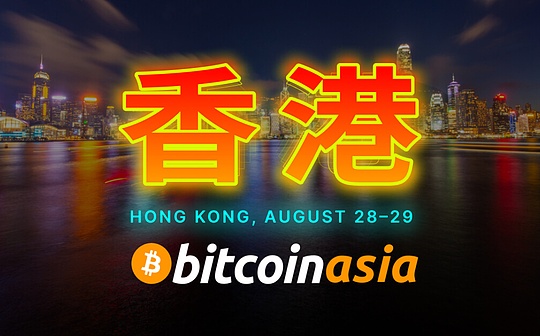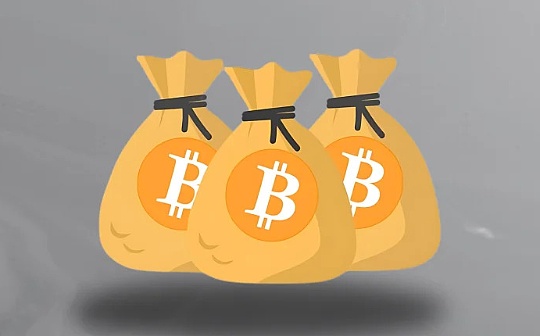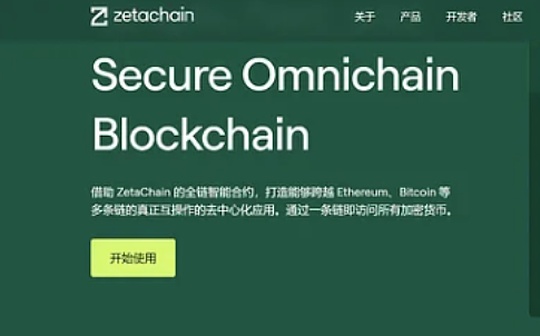
Author: AC-COR
Foreword
ZetAChain (Zeta) is a 1 -layer blockchain, which aims to bridge the gap between various blockchain networks.Using COSMOS SDK and Tendermint consensus mechanism, it enables developers to customize to build scalable interoperable applications.The platform allows decentralized applications (DAPP) to use the ability of multiple blockchain to solve the current cross -chain protocol problem and implement the full -chain and cross -chain function.The use of all -chain smart contracts and Zetaevm engines promotes interoperability, making Zetachain a central integrated center.
ZetAChain working principle
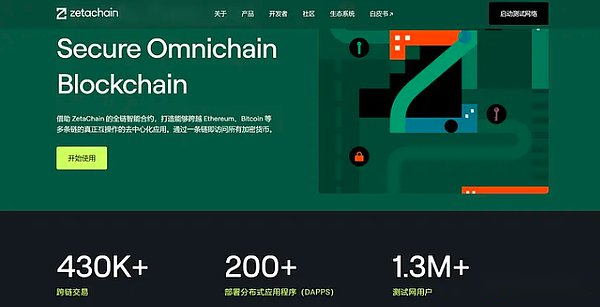
Image source: Zetachain official website
ZetAChain uses COSMOS SDK to show the unique All -chain interoperability based on the Tendermint consensus engine and equity proof (POS) model.It uses its own tokens as GAS costs, and has the advantage of expanding the full -chain EVM smart contract.As Jed Barker explained, the operation of Zetachain is as follows:
-
All -chain smart contract: The core of Zetachain is a smart contract that can interact with multiple blockchain.These smart contracts are supported by the Zetaevm engine, which is compatible with Ethereum virtual machines, allowing data interaction across blockchain;
-
Seamless asset transfer: Simplify asset transfer between blockchain without complex bridges.This includes a blockchain that supports the function of no native smart contract, such as Bitcoin;
-
Cross -chain message transmission:For simpler data exchange (such as NFT transmission), Zetachain provides cross -chain message transmission capabilities to promote lightweight data transmission between different networks;
-
Manage external assets: Zetachain extend its function to managing assets on other blockchain, applying smart contract logic to chains that are usually lacking this function.
ZetAChain architecture
Like other architectures, Zeta can provide many cross -chain message transmission functions, but its unique advantage is that it supports the full -chain EVM contract. It is called “Thorchain with smart contracts” or “AXLAR with EVM”.It uses COSMOS SDK and CometBFT consensus to create a POS blockchain, similar to Thorchain.Zeta uses the Zeta tokens as a routing token passed by cross -chain messages.
The explanation is as follows: Zetacore is a client that generates blocks and runs Layer1, similar to other POS blockchain.ZetAclient is responsible for cross -chain operations, and other nodes run Zetacore and ZetAclient at the same time.Zeta nodes perform three key functions: verification, observation and signature, and each function is operated by different roles in each node.This architecture supports two key functions: all -chain smart contracts and cross -chain messages.
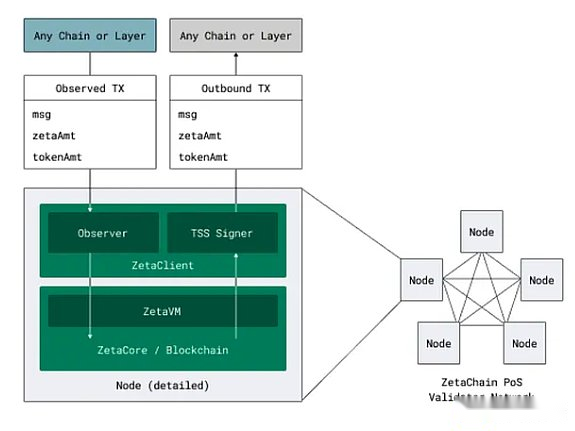
Image source: Delphi Creative
· Verification:Standard COMETBFT verifications, like the verificationrs on other POS chains, pledge Zeta and vote on the block;
· Observer:Observers need to run the entire node of the external chain, divided into sorters and verificationrs.The sorters supervise the incident on the external chain and send it to the verification person, and the verifier vote for the event to reach a consensus.The role of sorters is to ensure effectiveness; any node can sort the transaction.This makes running Zeta nodes higher than running standard chains, similar to Thorchain, which is one of the reasons why Thorchain does not add Solana support;
· Signaturer:Node sharing ECDSA/EDDSA key, only the vast majority (2/3) nodes can sign a transaction on the external chain.The signature is the method of custody assets and signed information on the external chain.On smart contracts such as Ethereum, they can be used to interact with smart contracts and custody assets, as well as custody assets on non -smart contract chains such as Bitcoin and dog coins.The following figure in the white paper shows the signature chart.
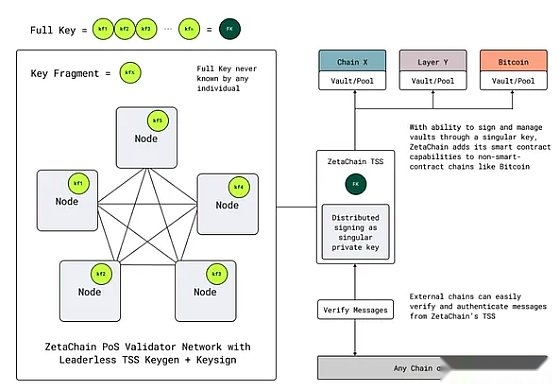
Image source: Delphi Creative
Cross -chain information transmission
CCMP uses ZetAChain as an intermediary to achieve information route between other chains.Other protocols, such as Layerzero, Axlar, IBC, Chainlink CCIP, and Thorchain to some extent, also compete in this direction.However, for Zetachain, their cross -chain message transmission protocol is implemented using its native currency Zeta, which basically distinguishes them from competitors.Except for ThorChain, other competitors do not rely on their native currency for value transfer.A cross -chain DEX example in the white paper visually shows the role of Zeta in message transmission.In this example, if the user wants to exchange 1.2 ETH to USDC on Ethereum on Polygon, the path is:
1. Exchange ETH to Zeta on Polygon AMM;
2. Send Zeta to ZetAChain;
3. Routing Zeta from ZetAChain to Ethereum;
4. Exchange Zeta to USDC on Ethereum;
5. The user receives the USDC USDC.
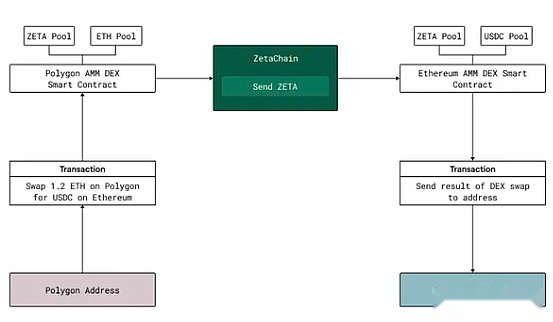 Image source: Delphi Creative
Image source: Delphi Creative
Although logically feasible, the solution requires a lot of funds, which has weakened its competitiveness with Squid and Uniswapx and the competitiveness of CIRCLE CIRCLE to a certain extent. The latter occupies a considerable market share as a settlement track.In addition to capital efficiency, cross -chain message transmission is also a fierce competitive field.
Cross -chain smart contract
The deployment of cross -chain smart contracts on Zeta provides developers with many benefits, not just using Zeta and Zevm to promote transactions.First, it can interact with assets that did not support smart contracts, such as BTC, Doge, LTC.Secondly, by positioning the application status on Zeta, the vulnerability attack surface is reduced to the greatest extent, and value transfer does not rely on the liquidity of the Zeta token.Among its competitors, except for Axlar’s use of COSMWASM instead of EVM, there are no other protocols to provide such products, and so far, they have not seen any use.
ZetAChain’s cross -chain smart contract is supported by the TSS protocol. Verifications run the full node on the external chain and share the signature. Therefore, they can represent ZetAChain and their user custody assets.Then Zevm can manipulate these assets as needed.It should be noted that, in the process, BTC does not transfer directly from Bitcoin to Zeta, but to the address custody of Zeta verification, and then expressed on Zetachain that similar to how ThorChain is a BTC that is held for protocol hosting, BTCAdd smart contract function.
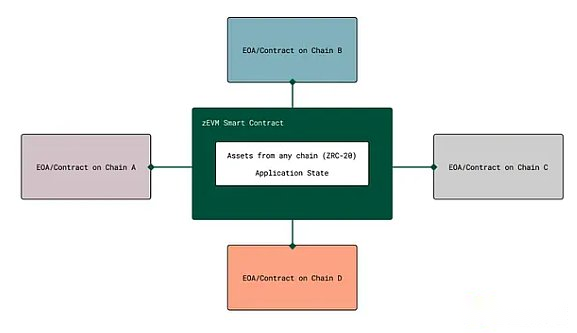
Image source: Delphi Creative
Under this framework, Zeta has the ability to develop many unique agreements, such as:
-
Cross -chain CDP stablecoin supported by BTC;
-
BTC, Doge, LTC, and other non -smart contract assets;
-
Cross -chain PERP DEX;
-
Cross -chain income polymer;
-
BTC AMM.
Fundamentally, the uniqueness of the combination of ZEVM and ZetaClient of Zetachain is that it is the custody and control of assets that do not directly support the chain of smart contracts.Although most cross -chain platforms are used as back -end infrastructure, Zetachain helps create its own cryptocurrency economy on Zetachain.
The practicality of Zeta tokens
As the cornerstone of the ZetAChain ecosystem, Zeta plays a vital role in programming and governance.ZetAChain is known for its interoperability and support for cross -chain DAPP, and key network activities depend on Zeta.
The main functions of Zeta tokens include:
-
Network incentive: The Zeta tokens use block rewards to motivate verified those, transitioning from a fixed pool to variable inflation.This system enables the interests of the verification to be consistent with the long -term security of the network;
-
Trading fee: Transactions in Zetachain require Zeta to pay GAS fees. These costs will be assigned to verificationrs and network participants, which will help prevent spam and DDOS attacks;
-
Cross -chain message transmission and value transfer: For cross -chain transactions, Zeta burns on the source chain and casts on the target chain without creating new packaging assets;
-
Core liquidity pool: The liquidity pool of ZetAChain consists of Zeta and other assets to promote user transactions and pay to liquidity providers
-
Governance role: Zeta holders participate in network governance and affect key decision -making and policy changes to ensure the development of the network and the community.
Overall, Zeta’s multiple aspects of practicality support Zetachain’s security, efficiency and decentralized governance, making it an important part of the network function.
Zeta token economy and distribution
The initial supply of the ZETA token is set to 2.1 billion pieces, and the annual inflation rate is planned to be about 2.5%of the per year after four years.Token allocation (see reference link 1) Strategic allocation to all parts of the ecosystem:
-
User Growth Pool (10%): It aims to expand the user base through airdrops and community rewards;
-
Ecological System Growth Fund (12%): Support the development of ecosystems, help partners and DAPP developers;
-
Verification (10%): For block rewards, after the initial stage, transition to inflation -based network security rewards;
-
Liquidity motivation (5.5%): Encourage the liquidity of the core ZRC-20 pool, which is essential for effective value transfer to;
-
Agreement vault (24%): capital operation, development and ecosystem reinforcement;
-
Core contributors, consultants and buyers (22.5%and 16%): reward the contribution to the development and growth of Zetachain.
Cross -chain DEX
Unlike the current cross -chain deployment, Zetachain, as the basic layer of the protocol, can realize the liquidity interoperability between all different deployments.For example, users on Zetachain can deposit margin into central contracts and hold GMX positions.This constitutes the core premise of the Zeta cross -chain application (position management is located on Zeta), which means that users who want to use all liquidity of GMX need to use Zetachain.
In addition to ensuring the quality of execution, there are two key advantages:
-
Similar to the MUX polymer (see Reference Link 2), it allows to split asset orders across various liquidity sources;
-
You can access more transaction pairs without manually connecting all relevant chains.
Smart contracts on Zetachain can directly deposit the required margin amount into the relevant chain, as well as how to use these asset explanations.Although this process does not require ZetAIN technically, it can enhance the user experience through the following ways:
-
Promote the interaction between chain;
-
Allow comprehensive management rather than isolation management.
UNISWAP, a market leader in the Dex field, may transfer its operating center from Ethereum to any other chain.However, in theory, by deploying on Zetachain and using the ZRC-20 standard, users can (across any chain) exchange and exchange any assets, and as the assets described on the custody of any chain they choose.
ZetAChain’s competitors
Layerzero
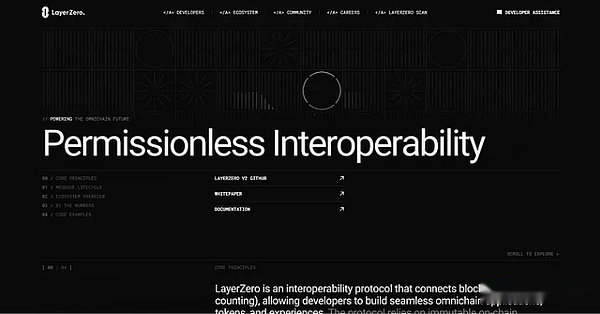
Picture source: layerzero official website
In the cross -chain transfer market, Layerzero is the biggest competitor of Zetachain.Although Layerzero does not participate in competition in the field of all -chain smart contracts, Layerzero’s market position in cross -chain transfer is very stable.The main advantage of Layerzero comes from Stargate, followed by Layerzero’s promotion of OFT standards (providing a new solution for cross -chain token transfer, making the tokens transfer between different chains simpler and efficient).
Layerzero architecture
Let me briefly introduce, Layerzero is an agreement that allows “user applications” to send information across blockchain.This architecture consists of 4 main parts:
-
User application: contract with Layerzero Endpoint and send/receive information (such as Stargate);
-
Layerzero Endpoints: A series of smart contracts on different chains (currently supports more than 40, see reference link 3).Endpoint allows the user to agree to send information through Layerzero back end, consisting of 4 modules: Communicator, Verifier, Network, and Libraries.The first three modules are standardized on all chains, and libraries are customized according to different chain logic, so that Layerzero can quickly add more chains;
-
Prophecy machine: Responsible for reading the block header from one chain and sending it to another chain.At present, this role is borne by Chainlink by default, but since September 2023, the new partnership with Google Cloud has replaced ChainLink as the default role;
-
Relay: similar to the relay, but they obtain proofs rather than the block head.Although the application itself can act as a relay, it is actually processed by Layerzero.
This design can be essentially a 2/2 more signature. The main trust assumptions are Google Cloud and Layerzero.Relying on these under -chain components (such as prophecy machines and relayrs) can benefit from lightweight, cheap and scalable architecture, but also have the shortcomings that rely on two centralized entities, which may make it face the risk of review.
Axlar
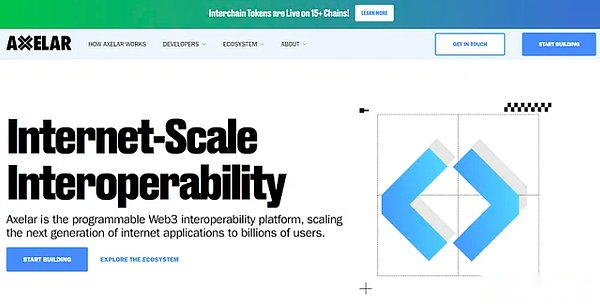
Photo source: axlar official website
Compared with Layerzero, Axlar’s structure is more similar to Zeta, but it is also significantly different.Like Zetachain, Axlar is also developed using COSMOS SDK.But it does not directly host EVM, so it does not support the same type of full -chain smart contract as Zeta.Therefore, the target market of Axlar is cross -chain messages, similar to Layerzero.
Axlar architecture
Axlar is a POS chain, which has a validated collection and pledged token AXL. It consists of the following components and processed information:
-
Cross -chain GMP request: Allows applications to send any data across the chain.These messages were sent to the Axlar gate (using blockchain technology to transfer digital currencies from one address to an online platform or digital system from one address to another address);
-
Gateway: The cross -chain message initiated by users/applications from the source link to the first stop of the target chain.For the EVM chain, these are smart contracts, and for COSMOS, these are application logic.The gateway is protected by the AXLAR verification of the MPC, and its share is entrusted by the AXL token to weighing;
-
Message processing and relay: relay monitoring incident (gateway information) and submitted it to the Axlar network for processing.Although anyone can run the relayr, there is no incentive mechanism, and the relay is operated by Axlar;
-
Information verification: The verifications vote for the information received by the relatives.Each Axlar verification person runs a complete node for each source chain to verify the effectiveness of the message.Compared with the typical COSMOS POS blockchain, the verifications rely on the light client and IBC to send messages, and the Axlar verifier needs more resources.In a sense, the scalability of this model is not as extensive as Layerzero, but it provides a higher degree of decentralization.Ax Lar inspires the verification by additional monitoring rewards; the more they support the more, the more rewards they get.In the long run, the support chain needs to be sufficient from cross -chain activities, because the tokens who support the tokens that support more than 50 full nodes will be exhausted.Supporting each chain may not be feasible; on the contrary, they may focus on the main liquidity chain;
-
Submit information to the target chain: The relay supervisor listened to the authorized information from the Axlar validator and pushed it to the gateway to the target chain.Once the target chain receives the approved information, its effective load will be approved by Axlar verification.Now anyone can execute the valid load;
-
GAS and Activator Services: In the last step, Axlar deployed a contract called “GAS Receiver” on the EVM chain to pay for GAS costs on the target chain and execute cross -chain loads (send it to the required application)EssenceUsers can use the source chain GAS tokens for payment, while Axlar is drawn from the GAS of the target chain.
Overall, in addition to supporting EVM on its own chain, its structure is similar to Zetachain, but only supports EVM on its own chain.In terms of security, Delphi Research believes it is safer than Layerzero’s 2/2 model, although there are still some shortcomings.Because applications can run their relatives, the possibility of collusion between Google and Layerzero is very low.
Chainlink ccip

Picture source: chainLink official
The cross -chain interoperability protocol (CCIP) is not much different from other cross -chain information platforms. The user sends information on a chain, the information is forwarded to CCIP, and then CCIP forwards the information to the target chain.CCIP’s uniqueness is how it uses Oracle Networks and adds another entity: Risk Management Network (RMN).
CCIP is divided into two parts on the chain and underneath.
Component on the chain:
-
Routers: Initiating cross -chain transactions.Pay the transaction route to the onramp contract specific to the destination, receive information from the OFFRAMP of the target chain, and the route to the end user/contract;
-
Submit storage: Submit Don to store the source chain Merkle root on the target chain.Merkle root must go through the “verification” of the risk management network;
-
Onramp: A contract of each chain (blockchain to the blockchain).Verify information and track token transmission/information, management billing, etc.Monitoring by Committing Don;
-
Office: Similar to onramp, one contract for each chain.Merkle root verification is used to submit and “verify” to execute DON to ensure the authenticity of the information and pass the information to the router;
-
Token pool: tokens can be “locking and casting” or “burning and casting”, depending on the token.For example, because CCIP does not have a casting right, it is necessary to lock and cast the native GAS token.If you integrate with CCTP, USDC can “destroy and cast”;
-
Risk management network contract: It contains a list of risk management network nodes that can be “verified” (approval) or “invalid” (non -approval) transactions.
Moto under the chain:
-
Commithting Don: As mentioned earlier, Committing Don monitor the onramp contract event, wait for the source chain result, and create Merkle ROOT (signature by the statutory Committing Don prophecy machine node), and finally write into the COMMIT Store contract of the target chain;
-
Risk management network: a node network, which is essentially a double inspection of the Merkle root submitted by DON.They monitor the onramp contract and the content published in the storage of Committing Don.If RMN does not “verify” (that is, verification/confirmation) Merkle Root, CCIP will freeze;
-
Execute DON: Similar to submission, but supervise the risk management network and other information.Once the RMN is issued “verification”, executing DON will call the OffRamp contract to complete the CCIP transaction of the destination.
Summarize
In fact, it is necessary to break the isolation effect between chain and solve the problem of “multi -chain communication” and “cross -chain communication”.Compared with other solutions, the core advantage of the ZetAChain project is its cross -chain interoperability capabilities, making it possible to interoperate between different blockchains and solve the problem of current blockchain fragmentation and lack of interoperability.Its goal is to enable the full -chain DAPP to directly interact with different blockchain without the need to pack or bridge any assets.However, there is a security risk in the external chain connected to the ZetAChain, which may lead to dual expenditure, review, restructuring, hard fork, chain division, etc.
At present, Layerzero and Axlar are leading in cross -chain information applications.However, it is too early to announce who is the final leader.While looking forward to the new Zetachain solution, I also look forward to the continuous iteration and innovation of Layerzero, Axlar, ChainLink CCIP, etc.
Reference information:
1. The FUTURE OPPPPPPPPUNITY for Full-Chain Applications https://members.delphidigital.io/Zetachain- PART- 2-AHEAD-FOR-Mnicha In-Applications#Consumer-Aggregation-APPS-IMPROVING-The-ON-Chain-Derivatives-EXPERIENCE-56D5
2. What iszetachain? Https://www.datawallet.com/Crypto/what-s-zetachain
3. The Competitive LandScape of Blockchain Bridging https://members.delphidigital.io/Zetachain-PART-A-COMPETITIVE-OF- Blockcccccccccccccc hain-bridges#Architecture-ED17
Additional links:
1. Zeta Token Distribution https://www.zetachain.com/docs/about/token- utility/distribution/
2. MUX Aggregator Whitepaper https://docs.mux.network/protocol/Leveraged-trading- Aggregator
3. Supported Contracts by Layerzero https://layerzero.gitbook.io/docs/technical- reference/mainnet/supported-chain- Ids

